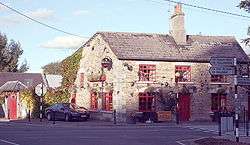Geashill
Geashill /ˈɡiːʃəl/ (Irish: Géisill) is a village in County Offaly, Ireland. It is situated between the towns of Tullamore and Portarlington on the R420 regional road. Geashill has a Church of Ireland church, a shop and petrol station, a post office, a school, a GAA club and two public houses.
Geashill Géisill | |
|---|---|
Village | |
 Pub in Geashill | |
 Geashill Location in Ireland | |
| Coordinates: 53°14′12″N 7°18′53″W | |
| Country | Ireland |
| Province | Leinster |
| County | Offaly |
| Elevation | 89 m (292 ft) |
| Population (2016)[1] | 395 |
| Time zone | UTC+0 (WET) |
| • Summer (DST) | UTC-1 (IST (WEST)) |
| Irish Grid Reference | N450206 |
History
The name Geashill is an anglicisation of the Irish name Géisill. Older anglicisations include Geashil, Geshill, Geshell, Geisshell and Gessill.[2]
Medieval Geashill
An ancient place named Brí Dam was situated in or near Geashill[3]; it boasted its own sacred tree (Old Irish: bile Brí Daim) that was mentioned in Lives of Saint Patrick. Brí Dam in 600 became the place of death of king of Uisnech (according to some sources - King of Ireland) Suibne mac Colmáin, who was killed near an unidentified stream.
An Anglo-Norman settlement was built here between 1185 and 1204 by the first Baron of Offaly, Gerald Fitzmaurice Fitzgerald, an ancestor of the Earls of Kildare. Originally of motte-and-bailey design, it was a timber castle on an earthen mound, nearby were located the church and tenant dwellings. In the 15th century the wooded fortress was replaced by a stone tower house. Today, only the west wall of the castle remains.
In 1598, Lettice Fitzgerald, daughter and heir of Gerald, the Lord Offaly of the time, married a Robert Digby of Coleshill, Warwickshire, who was brother of the 1st Earl of Bristol and whose son was created Ist Baron Digby of Geashill in 1620.
19th century
_-_geograph.ie_-_1827184.jpg)
The Digbys developed Geashill as a planned estate village. Samuel Lewis, writing in 1837, described the village as containing 87 mostly thatched houses arranged around a triangular green.[4] Fairs were held on 1 May, 6 October and December, the latter being one of the largest pig markets in Ireland. Consisting of over 34,000 acres (140 km2), the Digby estate was the largest in County Offaly.
Edward St Vincent Digby, the 9th Baron Digby, came into the estate in 1856, but had no money to keep it. Consequently, he evicted a large number of families from their lands. A local priest, Father Patrick Dunne, arranged for 400 people to be taken to Australia on a ship named the Erin-go-Bragh, which took a record 25 weeks to reach Moreton Bay; 51 passengers died en route.[5] Following the evictions, Digby carried out extensive improvements in the 1860s and 1870s and many of the current buildings around the triangular green date from this time. The Kings County Directory recorded that Digby had "converted the village of Geashill into what it now is, one of the neatest, cleanest and best kept in Ireland."[6]
At the Paris Exhibition of 1867 Digby was awarded the bronze medal for models of the village he was building. He was awarded the gold medal for three years by the Royal Agricultural Society, for improving the greatest number of cottages in the best manner in the Province of Leinster. The Digbys built a house called Geashill Castle near the medieval tower house but this was burnt down during the Civil War in 1922.[7]
Transport
Geashill railway station opened on 2 October 1854, was closed for passenger traffic on 17 June 1963 and finally closed altogether on 30 August 1982.[8]
References
- "Sapmap Area - Settlements - Geashill". Census 2016. Central Statistics Office. April 2016. Retrieved 27 February 2020.
- Placenames Database of Ireland (see archival records)
- Hogan E. Onomasticon Goedelicum Locorum et tribuum Hiberniae et Scotiae: An Index, with Identifications, to the Gaelic Names of Places and Tribes. Dublin - London, 1910, s.v. Brí Dam
- http://www.libraryireland.com/topog/g.php
- Boland, Thomas Patrick (1964). ""The Queensland Immigration Society" : a notable experiment in Irish settlement" (PDF). Journal of the Royal Historical Society of Queensland. 7 (2): 317–18. Retrieved 22 May 2014.
- https://web.archive.org/web/20071117033620/http://www.irishmidlandsancestry.com/content/offaly/community/kings-quinnsland.htm
- https://web.archive.org/web/20080627013908/http://www.r-alston.co.uk/ch_ire.htm
- "Geashill station" (PDF). Railscot - Irish Railways. Retrieved 14 October 2007.
